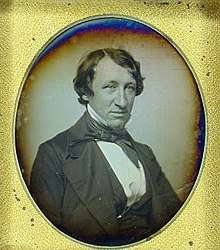Samuel Cabot III
Samuel Cabot III (September 20, 1815 – April 13, 1885) was an American physician, surgeon, and ornithologist, as well as a member of the wealthy and prominent Cabot family.

Early life
Samuel Cabot III was born in Boston, Massachusetts on September 20, 1815 to Samuel Cabot, Jr. and Elizabeth Perkins. Cabot graduated from Harvard University in 1836, and then proceeded to get his medical degree at Harvard Medical School in 1839.[1]
Medical career
After this, Dr. Cabot went to Paris, France for further studies. He returned to Boston in July 1841, but then joined a group of academic explorers in the Yucatan in 1842, serving as their physician. In 1844, he set up his own medical and surgical practice in Boston, which he maintained for the rest of his life. Additionally, he was employed by the Massachusetts General Hospital.[2]
Politically, Cabot was an abolitionist and, therefore, volunteered himself as surgeon during the American Civil War. He was also ordered to inspect army hospitals in 1863.[3]
Ornithological career
Cabot was also a noted ornithologist. He collected many birds from his trip to the Yucatan in 1842, including many that were first described by him. At one time he was the curator for the Boston Society of Natural History, which during the early years had a smaller collection of birds than Cabot's personal collection.[4] Cabot published many ornithological papers, until he ultimately had to retire as an ornithologist in the 1850s to focus on his medical career.
His bird and egg collection was given to the Boston Society of Natural History after his death in Boston in 1885. The Chinese pheasant, Cabot's tragopan, was named after him.[5]
Personal life
In 1844, Cabot married Hannah Lowell Jackson. Together, they had eight children, including industrialist Godfrey Lowell Cabot and artist Lilla Cabot Perry. His father, Samuel Cabot, Jr. and his grandfather, Thomas Handasyd Perkins, were two of the wealthiest men in 19th century Boston. Two of his brothers include philosopher James Elliot Cabot and architect and artist Edward Clarke Cabot.
References
- Briggs, L. Vernon. History and Genealogy of the Cabot Family., 1927
- Briggs, L. Vernon. History and Genealogy of the Cabot Family., 1927
- Kelly, Howard A. American Medical Biographies. 1920
- Kelly, Howard A. American Medical Biographies. 1920
- Allen, J. A. The Auk. Vol. 3. 1886